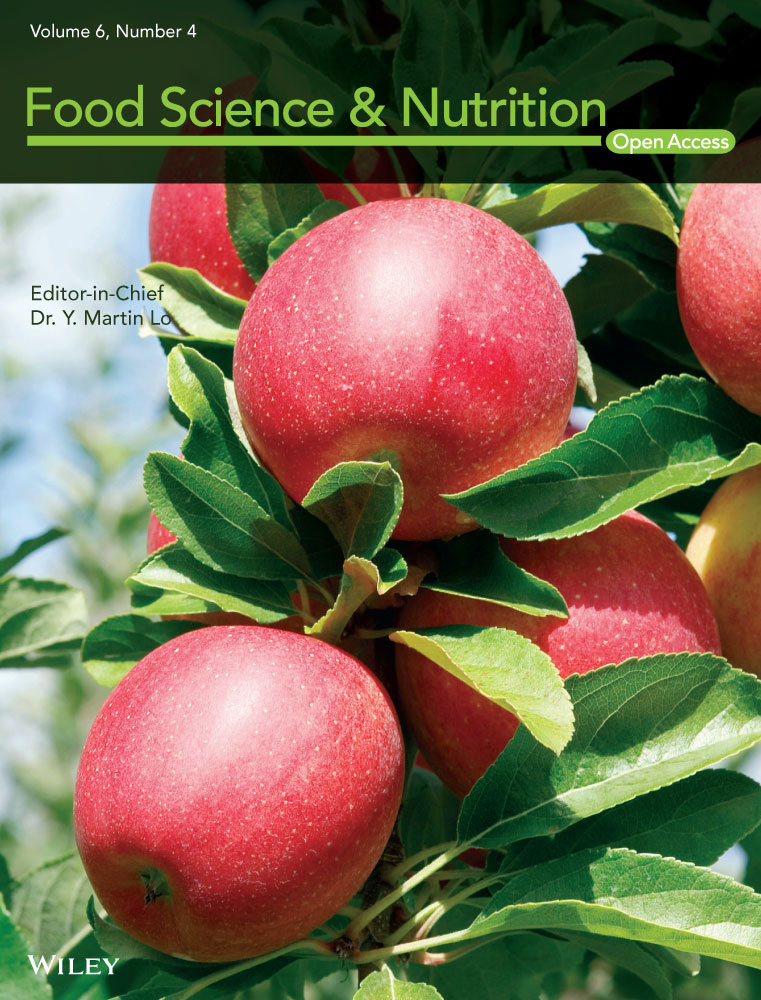Mining online activity data to understand food consumption behavior: A case of Asian fish sauce among Japanese consumers
Abstract
Internet search engines and online recipe repositories have become increasingly popular resources among households for recipes and meal planning. Meanwhile, fish sauce's distinct flavor makes it a popular condiment in Southeast Asian countries. Although fish sauce is used as a condiment for traditional cuisine in Japan, it is not popular for general household use. To understand the consumption behavior regarding fish sauce in Japanese households, we analyzed search trends for the words nampla (Thai fish sauce), nuoc mam (Vietnamese fish sauce), and shottsuru (Japanese fish sauce) using Google's search engine and the Japanese online recipe site Cookpad. The results clearly indicate nampla's rising popularity due to the rapid spread of Thai cuisine and an annually increasing traditional consumption of Japanese fish sauce. These results provide insights into the household demand for fish sauce.
1 INTRODUCTION
Consumers choose food based on many factors, such as flavor, appearance, nutritional value, function, and the package's label (Borgmeier & Wstenhoefer, 2009). Further, familiarity with the food is an important factor in consumer acceptance (Verneau, Caracciolo, Coppola, & Lombardi, 2013). Food researchers and developers analyze consumers' preferences and acceptance by conducting consumer surveys and interviews (Honkanen & Frewer, 2009; Kearney, Kearney, Dunne, & Gibney, 2000; Milošević, Žeželj, Gorton, & Barjolle, 2012); they can then construct new product concepts and produce pilot-scale products based on this research. This traditional approach to product development requires many respondents for questionnaires, interviews, and sensory evaluations. The quality of the questionnaire and interview analyses primarily depends on the prepared questions as well as the interviewers' capabilities (Bastian, Eggett, & Jefferies, 2015).
Currently, information technology has enabled the accumulation of large amounts of data from social Web sites and the simple extraction of such data using search engines. Economists (Carrière-Swallow & Labbé, 2013; Choi & Varian, 2012; Vosen & Schmidt, 2011), policymakers (Ripberger, 2011), epidemiologists (Carneiro & Mylonakis, 2009; Seifter, Schwarzwalder, Geis, & Aucott, 2010), and biologists (Mccallum & Bury, 2013; Proulx, Massicotte, & Pépino, 2013) increasingly use accumulated online data to understand markets, public opinion trends, and the spread of human infectious diseases, and to observe creatures' behaviors. Recently, in addition to Web sites that provide general information, online recipe sites—such as Cookpad (https://www.cookpad.com) and Allrecipes (http://www.allrecipes.com)-have become popular among households to find recipes shared by users and plan meals.
Meanwhile, fish sauce is a brown dressing widely consumed in most Southeast Asian countries and is referred to by different names across countries: nampla in Thailand, nuoc mam in Vietnam, and shottsuru in Japan (Akita Prefecture in particular). Generally, fish sauce is produced by fermenting fish material and salt (Fukami, Funatsu, Kawasaki, & Watabe, 2004), and microorganisms are often used to catalyze fermentation. During this fermentation process, the proteins in the fish material are hydrolyzed into amino acids and peptides, both by endogenous and by microorganism proteases, which results in the fish sauce's distinctive taste (Lopetcharat, Choi, Park, & Daeschel, 2001; Taira, Funatsu, Satomi, Takano, & Abe, 2007). The fermentation process also produces volatile compounds responsible for its characteristic odor (Yongsawatdigul, Rodtong, & Raksakulthai, 2007; Zheng et al., 2017).
Soy sauce and miso are fermented foods made from soybeans and are widely consumed as condiments in Japan. However, it is difficult to acquire soy sauce and miso in coastal areas due to a lack of soybeans. Therefore, fish are used to produce a substitute for soy sauce; fish sauce is primarily homemade, resulting in a unique fish sauce-related food culture in limited areas of Japan. Nonetheless, homemade fish sauce production declined due to the emergence of industrial production and subsequent commercial availability of soy sauce and miso, caused by a drastic change in Japanese society after the Meiji era (Ishige, 1986). Thereafter, fish sauce was only produced in limited areas (i.e., shottsuru in Akita Prefecture and ishiru in Ishikawa Prefecture). Our recent investigation indicates that the Japanese people have gradually lost interest in fish sauce produced in Japan (Nakano et al., 2017). Despite waning consumer demand, fish sauce production has gained attention, and many local fish sauce products are produced to revitalize local communities, which have an advantageous, abundant supply of inedible fish material at a low market value that can be used for fish sauce production. This indicates a substantial gap between consumer demand and supply.
In this study, we use Google Trends, which enables the plotting of Google search queries related to a particular topic, to analyze fish sauce consumption behaviors in Japan. Additionally, we employ Tabemiru, a tool provided by the online recipe repository Cookpad that enables an analysis of recipe use frequencies, to examine households' fish sauce consumption. The combined data from Google Trends and Tabemiru represent Japan's household fish sauce consumption behavior.
2 MATERIALS AND METHODS
2.1 Data collection from Google Trends
Temporal or regional trends in web searches for the terms of concern in this study were downloaded from Google Trends (https://trends.google.com/trends/). This public web facility of Alphabet Inc. (Mountain View, CA, USA) indicates how often people search for a term relative to the total number of searches, in various countries and languages. This study's data were collected by setting the location parameter to “Japan” and the time parameter to “2004-present.”
2.2 Data collection from Tabemiru on Cookpad
Cookpad, Japan's largest recipe site (http://www.cookpad.com), allows visitors to upload and search for original recipes. Tabemiru is an analysis tool provided by Cookpad Inc. (Tokyo, Japan) that allows visitors to examine how often Cookpad visitors use recipes, including relevant search terms. The frequency is expressed as the cook index (CI), according to which Tabemiru considers a recipe that has been uninterruptedly viewed for more than 10 min as “prepared by the site visitor.” The CI is calculated using the following formula: the number of times a recipe, including relevant search terms, was used for cooking/total number of recipes that were used ×1,000.
2.3 Statistical analysis
The correlation between Google Trends-based search volumes and household consumption behavior, as represented by the CI in Tabemiru, was assessed with scatterplots and regression statistics using both the coefficient of determination and Pearson's correlation coefficient. Additionally, the correlations between the search volumes for the terms for fish sauce and the dishes' names were similarly assessed. All statistical analyses were performed using Microsoft Excel (version 15.31; Redmond, WA, USA).
3 RESULTS
3.1 Google search trends for fish sauce among Japanese consumers
We entered the set of terms “ナンプラー”(nampla; Thai fish sauce), “ニョクマム”(nuoc mam; Vietnamese fish sauce), and “しょっつる” (shottsuru; Japanese fish sauce) on the Google Trends homepage in August 2017 to access the search trends for these three keywords. Figure 1a illustrates a Google Trends graph of the search frequencies for the three terms, from January 2004 to August 2017. Among the three terms, searches for nampla had the most traffic, or an average of nine times more than the nuoc mam searches, and three times more than the shottsuru searches. It is noteworthy that search trends for nampla peak in the summer and reach its minimum in the winter, which are remarkable after 2011. Conversely, the search trend for shottsuru demonstrates a sharp peak in December. Such seasonal search trends were not observed for nuoc mam. The search trends for the three terms for fish sauce on Google Shopping were also analyzed, as Figure 1b reveals. This indicates consumers' willingness to buy and a stronger interest than that of consumers who search using only Google's homepage. Searches for nampla occurred every year after 2012, while searches for shottsuru occurred only in the winters of 2011 and 2014. Nuoc mam searches were not observed for any year.
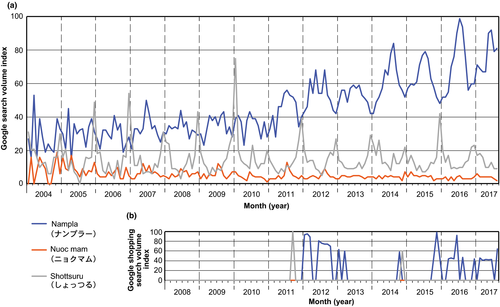
Google Trends also lists the prefectures with the highest search traffic for a given term. As Figure 2 demonstrates, 17 of 47 prefectures were listed for shottsuru searches, with Akita Prefecture indicating remarkably high search traffic. Alternatively, all prefectures in Japan widely searched for nampla. Searches for nuoc mam only occurred in metropolitan areas with large populations, such as in Kanagawa, Tokyo, Saitama, and Osaka prefectures.
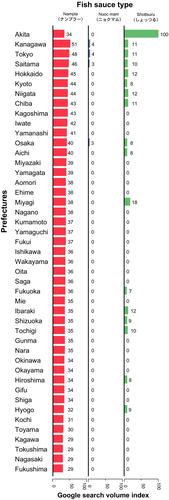
3.2 Household consumption behavior for fish sauces in Japan
We clarified the household consumption behavior for the three fish sauce types in Japan by analyzing their frequency from 2014 to 2017 in recipes that include nampla, nuoc mam, and shottsuru on Japan's largest online recipe repository, Cookpad. This was accomplished using Cookpad Inc.'s analysis tool, Tabemiru, which expressed this frequency as its cooking index (CI). As Figure 3a reveals, the frequency of the use of recipes that include nampla was 10 times higher than that of shottsuru, and 80 times higher than that for nuoc mam. The frequency of the use of recipes that include nampla increased every year after 2015, while that of shottsuru decreased every year since 2014.
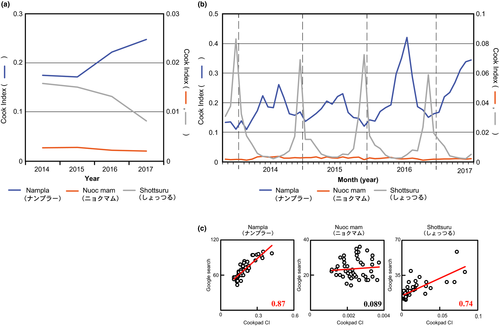
Figure 3b compares the monthly trends regarding the frequency of use for recipes that include the three fish sauce types. Similar to Google's search trends, the frequency of use of recipes that include nampla peaked in the summer, while those including shottsuru sharply peaked in winter. As the monthly Google search trends and the recipes' frequency of use exhibit similar behaviors, Pearson's correlation coefficient was used to analyze the correlation between these two datasets, as noted in Figure 3c. The results reveal highly positive correlations for nampla and shottsuru in the Google search frequency and recipes' frequency of use as represented by the CI. The Pearson's correlation coefficient was 0.87 for nampla; consequently, a high correlation exists between people's interest and household consumption for both nampla and shottsuru.
Next, we analyzed foods that used nampla, nuoc mam, and shottsuru in the recipes on Cookpad using Tabemiru. As Table 1 indicates, shottsuru is almost always used as a condiment in shottsuru nabe, a Japanese stew with konbu (kelp) and hata-hata (Japanese sandfish). The stew is a traditional dish in Akita Prefecture (Ishige, 1986). The data also indicate that nuoc mam is used as a dipping sauce for various foods or a condiment for fried chicken or other meat. Alternatively, the data also indicate a drastic change since 2016 in nampla's household use. Figure 4 indicates the CI for each food that used nampla; the constant CI scores for meat, fries, and soup throughout 2014 to 2017 imply that nampla was used as a condiment for fried meat, fries, and soup. Further, the data demonstrate a rapidly increasing interest in the search terms “gapao” and “rice,” referring to a new Thai dish called gapao rice that became popular in Japan around 2015 to 2016. The upper panel in Figure 5 indicates a Google Trends graph of the search frequencies for ナンプラー (nampla) and ガパオ (gapao) from January 2004 to August 2017. This panel implies that the trends in nampla's popularity are strongly linked to those of gapao, and these terms have increased in popularity since 2012. Additionally, the search frequency for the termタイ料理 (Thai foods) has increased since 2012. These results indicate that Thai cuisine has gradually become popular in Japanese society, and especially with the increasing popularity of gapao rice, which has been consumed in households as well as restaurants specializing in Thai cuisine.
| Rank | Nampla(ナンプラー) | Nuoc mam(ニョクマム) | Shottsuru(しょっつる) | |||||||||
|---|---|---|---|---|---|---|---|---|---|---|---|---|
| 2014 | 2015 | 2016 | 2017 | 2014 | 2015 | 2016 | 2017 | 2014 | 2015 | 2016 | 2017 | |
| 1 |
お肉 (Meat) |
お肉 (Meat) |
ガパオa (Gapao) |
ガパオ (Gapao) |
タレb (Tare) |
炒め物 (Fries) |
お肉 (Meat) |
タレ (Tare) |
鍋c (Nabe) |
鍋 (Nabe) |
鍋 (Nabe) |
鍋 (Nabe) |
| 2 |
炒め物 (Fries) |
炒め物 (Fries) |
生米 (Raw rice) |
生米 (Raw rice) |
炒め物 (Fries) |
お肉 (Meat) |
炒め物 (Fries) |
お肉 (Meat) |
コンブd (Konbu) |
はたはた (Hata-hata) |
はたはた (Hata-hata) |
はたはた (Hata-hata) |
| 3 |
スープ (Soup) |
スープ (Soup) |
白米 (White rice) |
白米 (White rice) |
お肉 (Meat) |
鶏 (Chicken) |
鶏 (Chicken) |
炒め物 (Fries) |
はたはたe (Hata-hata) |
コンブ (Konbu) |
コンブ (Konbu) |
コンブ (Konbu) |
- a ガパオ (Gapao): Japanese pronunciation for กะเพรา, the Thai name for holy basil (Ocimum tenuiflorum), used in Thai cuisine. Gapao is a dish made of minced meat, fried with holy basil or sweet basil, and served with rice.
- b タレ (Tare): A dipping sauce for cooked food, such as yaki-niku (Korean-style barbecue) and gyoza (a dish that evolved from Chinese dumplings).
- c 鍋 (Nabe): Originally interpreted as a pan for boiling or stewing, the term also refers to food boiled in a nabe.
- d コンブ (Konbu): Kelp used to make dashi, a broth in various Japanese dishes.
- e はたはた (Hata-hata): Japanese sandfish (Arctoscopus japonicas).
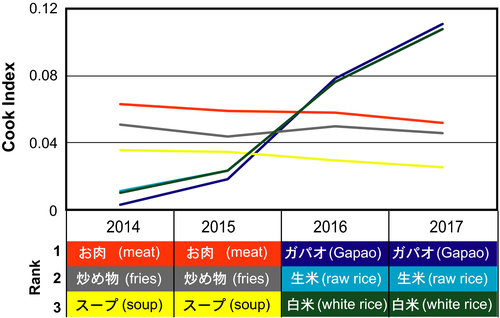
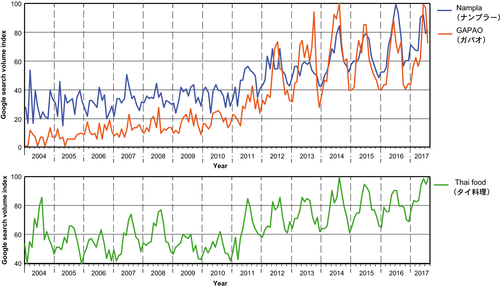
3.3 Nampla's increasing popularity as a condiment in Southeast Asian cuisine
As Figure 6 illustrates, nampla's search frequency significantly relates to those for gapao, pattai, tom yum goong, and nama-harumaki, which suggests that the people's interest in nampla relates to these dishes. Indeed, some Cookpad recipes for these dishes list nampla as a condiment. It is also noteworthy that nama-harumaki originated in Vietnam and uses nampla in place of nuoc mam. The search frequency trends for nuoc mam did not indicate relationships to any of the dish names analyzed in this study, including the Vietnamese dishes nama-harumaki and pho. The search trends for shottsuru relate to both shottsuru nabe and hata-hata.
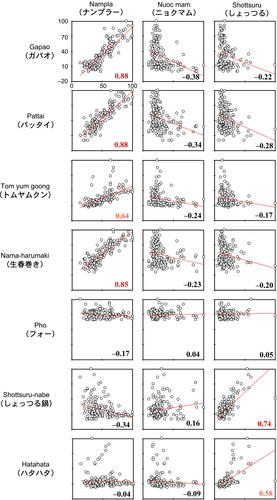
One reason for Thai cuisine's rapidly increasing popularity in Japan is the increasing number of visitors from Thailand. Figure 7 indicates that the number of visitors from Thailand to Japan has significantly increased since 2013. Moreover, the Japanese government permitted people from Thailand to enter the country without a visa in July 2013. This increase in visitors from Thailand may have promoted a cultural exchange, including the nations' cuisines.
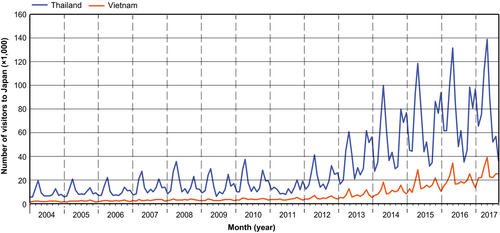
4 DISCUSSION
Fish sauce has been popular among Japanese households as a substitute for soy sauce, which is a condiment for traditional dishes, or as a dipping sauce (tare) for raw fish (sashimi) (Ishige, 1986). However, drastic changes in Japanese society have led to a decline in fish sauce consumption. Nevertheless, the production of a wide variety of fish sauces has continued throughout Japan, as some local communities have an abundant supply of fish and inedible fish material at a low market value, which can be used to manufacture the product. However, strategies to promote sales and product development are necessary for the industry to succeed. This study performed data mining on Internet activities (searches) related to fish sauce consumption among the Japanese.
The data mined from Google Trends indicate that fish sauce produced in Japan, represented by shottsuru, has a very limited purpose as a condiment for traditional nabe (Ishige, 1986; Nakano et al., 2017). Thus, there is currently an excess supply of fish sauce relative to consumer demand. Conversely, nampla has become widely popular in Japan due to Thai cuisine's rapidly increasing popularity in recent years, as represented by gapao rice. The data mined from Cookpad indicate that Thai cuisine has now spread to households, beyond the restaurants that serve such cuisine. These findings may have significant implications for the Japanese fish sauce industry. On the one hand, gapao rice's increasing popularity in Japanese society has led to an increased consumption of nampla. On the other hand, no dish has led to an increased consumption of Japanese fish sauce, and therefore, it is necessary to develop dishes that use this fish sauce. Additionally, suppliers must explain the benefits of unfamiliar foods to consumers or their households. For instance, fish sauce can be incredibly nutritious because of its essential amino acids (Gildberg, 2004). Additionally, fish sauce promotes various biological activities, including angiotensin I-converting enzyme inhibitory activity and the stimulation of insulin production (Ichimura, Hu, Aita, & Maruyama, 2003). The distribution of such useful information to consumers would be part of a sales strategy beneficial to the Japanese fish sauce industry.
The data mined from Google Trends and Tabemiru indicate the unique seasonal differences in consuming nampla and shottsuru, with peaks in the summer and winter, respectively. Japanese consumers tend to make spicy foods, such as ethnic foods, in the summer to prevent a loss of appetite. Recently, the cultural exchanges between Japan and Thailand have increased Thai foods' popularity as ethnic foods. Moreover, nabe cuisine is popular in the winter season. These reasons justify the seasonal trends demonstrated in Google searches for shottsuru as well as its usage on the Cookpad Web site.
Consumer research and sales data collection are needed for businesses' marketing research to understand consumers' preferences. This study indicates that an analysis of Internet data—using search trends from an Internet search engine and an online recipe Web site—provides a method to observe consumer preferences that complement existing methods.
CONFLICT OF INTEREST
None declared.



